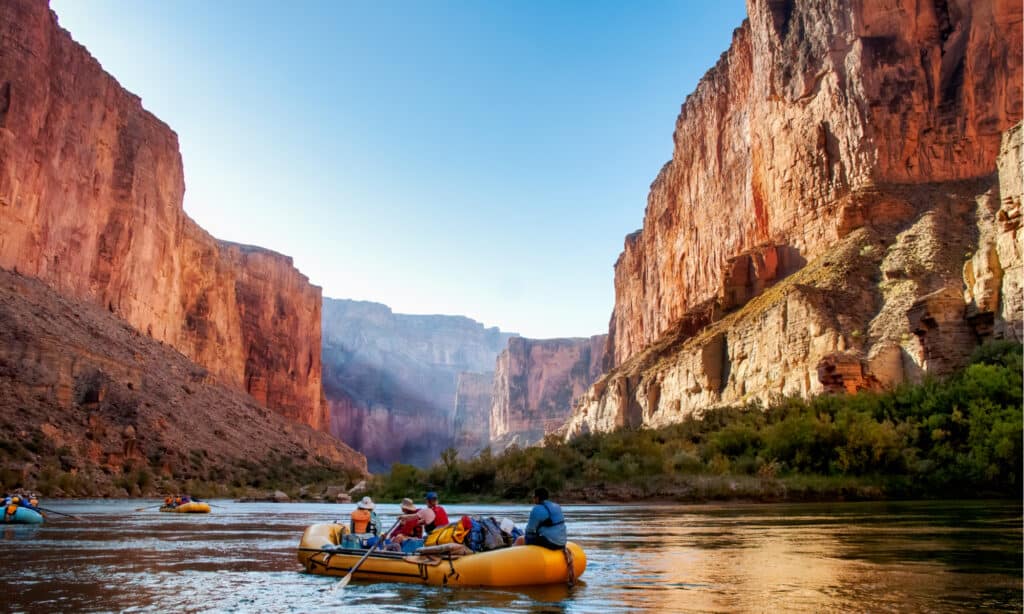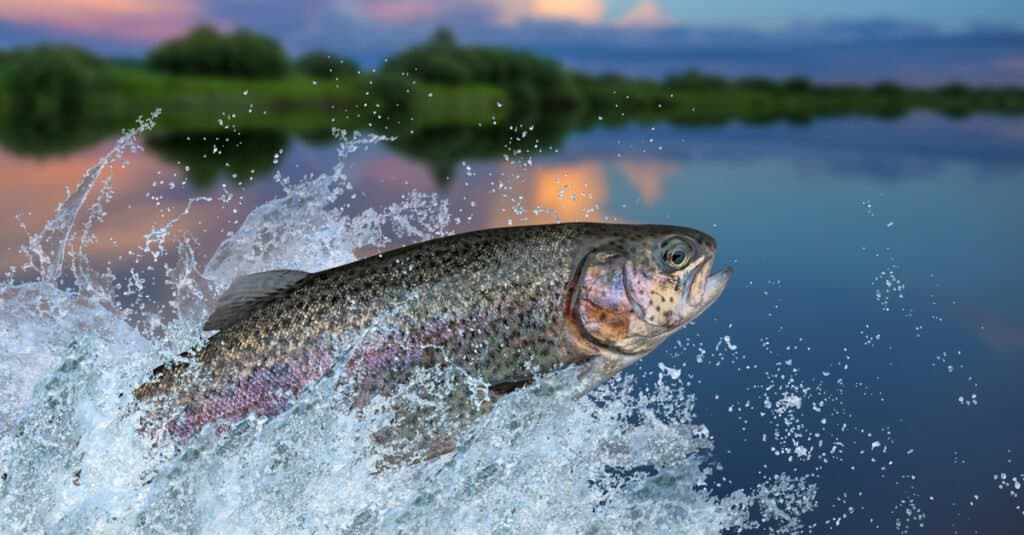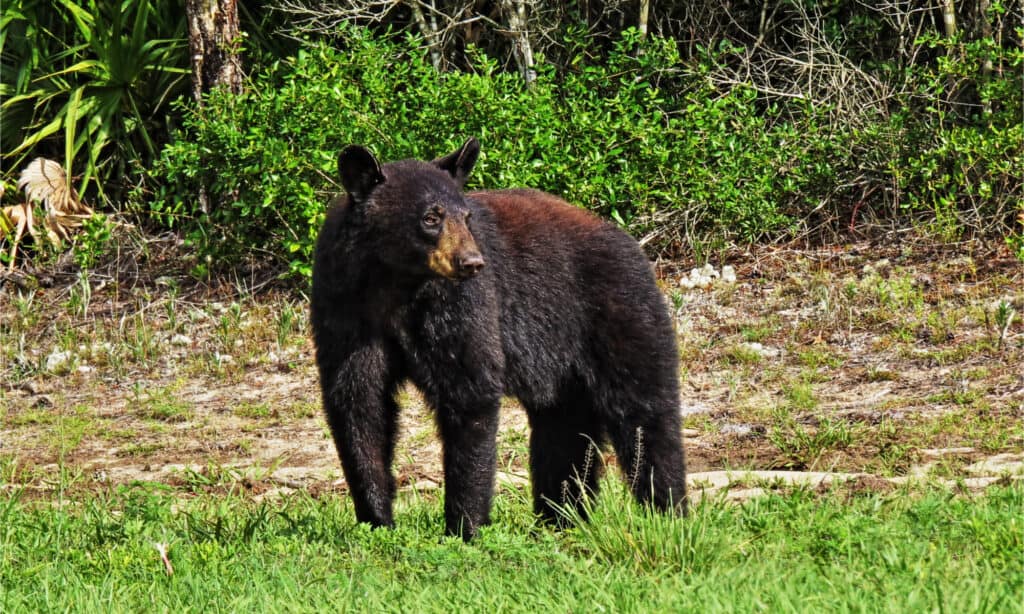The Snake River is 1,078 miles long, and it’s mighty.
The flowing waters have an average discharge of over 54,000 cubic feet per second. That’s why the river serves as one of our nation’s most potent hydrologic resources. The mighty river flows through vast plains, red rock canyons, pine forests, and other diverse landscapes.
Where does the Snake River start? Read on to find out.
Where Does the Snake River Start?

The Snake River starts in Grand Teton in Wyoming.
©Barry Bjork/Shutterstock.com
The Snake River starts in Wyoming. The headwaters include parts of Grand Teton and Yellowstone National Parks. It’s the largest tributary of the Columbia River.
The large river flows into Jackson Lake and eventually through Jackson Hole. Jackson Hole rests right between Teton ridge and the Continental Divide. This area is known as the Upper Snake River canyon.
Exiting the upper Snake River canyon, the Snake River joins with the Grey and Hoback Rivers. After entering the Palisades Reservoir in Idaho, the Snake River joins with the salt river.
South Fork
The South fork of the Snake River sits right below Palisades Dam. From there, it enters the Snake River plain. Over 95% of the Snake River Plain is completely covered by basaltic lava flows!
The South fork provides 54 miles of water. It’s a great spot for wild trout fishing.
North Fork
The North fork of the Snake River is southwest of Rexburg in Madison county, Idaho. The North fork is sometimes referred to as Henry’s fork. The North fork serves as the main stem of the river before the waters flow through downtown Idaho Falls.
The Rivers Journey and Major Tributaries
The snake river’s exciting journey continues as it flows into Fort Hall Indian Reservation. From there, it enters the American Falls Reservoir.
Continuing its Westward journey, the river drops over Shoshone falls and passes through Twin Falls. Heading towards Boise, Idaho, the main river meets with the Payette, Owyhee, and Boise rivers.
Hells Canyon and Beyond

The Snake River forms the boundary between Oregon and Idaho for a long stretch.
©Peter Hermes Furian/Shutterstock.com
The Snake River is famous for bordering the 200-mile-long Idaho- Oregon State border. The border follows the river into Hells Canyon.
After crossing into Washington, the river receives the Clearwater River at Lewiston. Lewiston is the uppermost major city on the stretch of the Snake River that’s navigable. As the Snake River leaves Hells Canyon, it spreads into the Palouse Hills of Eastern Washington.
Where Does the Snake River End?

The Snake River ends at the Columbia River.
©iStock.com/JPLDesigns
The Snake River ends at the Columbia River in the pacific northwest region of the United States. It’s the largest tributary of the Columbia River.
As one of the most important rivers flowing in the region, the Snake River serves many purposes. The dams that harness the river’s power have helped transform the region’s economy.
States With River Access
You can access the Snake River in Eastern Oregon, Southern Idaho, Southeast Washington, and Northwest Wyoming. It’s one of the West’s most scenic aquatic ecosystems.
Flowing from the river headwaters in Wyoming, the river travels across the full breadth of Idaho until it reaches its mouth near Washington’s tri-cities.
Hydroelectric Power Opportunities

The lower portion of the Snake River has 4 large dams. The upper portion of Snake River has 3 large hydroelectric dams.
©Rocknross52 / Creative Commons – License
The Snake River has undergone a lot of modifications through the years. The dams built along the river and its tributaries help provide irrigation and hydroelectric power to the region. Dam sizes range from minor diversions to extremely high dams.
There are 4 large dams on the Lower Snake River in Washington. These dams were built and operated by the US Army Corp of Engineers. The 4 dams include Ice Harbor, Lower Monumental, Lower Granite, and Little Goose.
In the upriver area near the Hells Canyon region, there are 3 large hydroelectric dams. The 3 dams include the Oxbow Dam, Hells Canyon Dam, and Brownlee Dam.
What Is the Snake River Known For?

The Snake River is perfect for white water rafting.
©Jim Mallouk/Shutterstock.com
The Snake River is known for being one of the best places for white water rafting! If you’re a thrill-seeker, you have to try it out.
The river’s canyon provides some of the most exciting rapids. People from all over the world head over to the canyon to hop on a raft and experience the intense rapids for themselves.
Did you want to bring everyone? You can find family-friendly white water rafting trips throughout the river’s canyon. A standard trip usually runs for about an 8-mile stretch through Hells Canyon.
What Kind of Fish Are in the Snake River?

The Snake River is home to trout, smallmouth bass,
catfish
, walleye, and northern pike.
©FedBul/Shutterstock.com
The Snake River has smallmouth bass, catfish, walleye, and northern pike. One of the most common fish in the Snake River is the mountain whitefish. Where you fish along the river plays a big role in the catches you’ll be able to make.
Henry’s Lake
Henry’s Lake has rainbow cutthroat trout and brook trout. You can find Henry’s Lake nestled between Henry’s Lake Mountains and the Centennial Mountains.
The lake is fed by multiple small springs and streams. It’s the type of place that anglers dream about!
Henry’s lake is 3.5 miles wide and 4.5 miles long. The shallow lake only reaches 25 ft in the deepest spots. The shallow water makes it a prime spot for fly fishing.
Palisades Reservoir
The Palisades Reservoir has cutthroat trout, lake trout, and brown trout. It’s a breathtaking body of water in Eastern Idaho. The reservoir is on US Highway 26, right by the Wyoming and Idaho border.
Wildlife Viewing Opportunities Along the River

You can find black bears, elk, mule dear,
peregrine falcon
, wolves, and mountain lions by the Snake River.
©Roger Epps/Shutterstock.com
Wildlife around the Snake River includes elk, mule deer, mountain lions, wolves, rabbits, and black bears. Some of the best wildlife viewing opportunities happen between the Snake River Range and the Caribou Range.
If there’s a specific animal you want to see, you’ll want to find out the best time of year to visit. If you have your heart set on spotting an elk, you’d want to visit during the elk mating season in the fall.
How Did the Snake River Get Its Name?
The Snake River probably got its name from European explorers. Over 11,000 years ago, the Snake River was inhabited by prehistoric Native Americans known as the Shoshone.
The Shoshone people had a hand signal to communicate that they lived by a river with many fish. However, the settlers misunderstood their hand signal.
The settlers thought the Shoshone people were making a snake symbol. The miscommunication stuck, and the long United States river became known as the Snake River.
The photo featured at the top of this post is © iStock.com/ablokhin
Thank you for reading! Have some feedback for us? Contact the AZ Animals editorial team.






